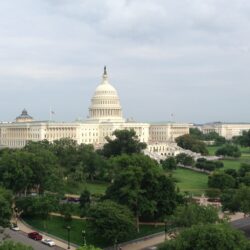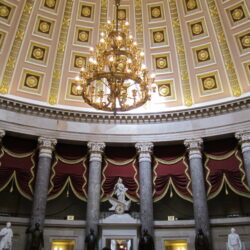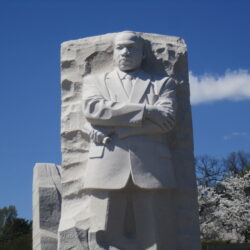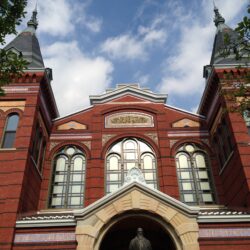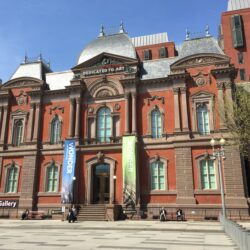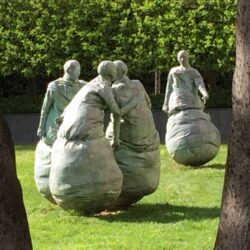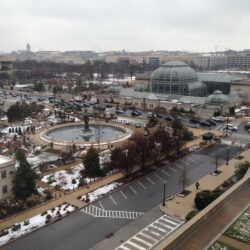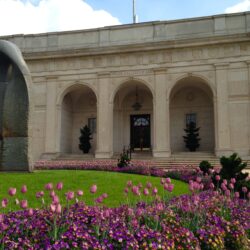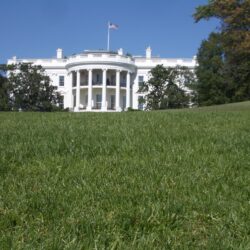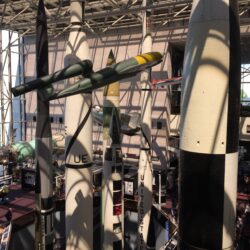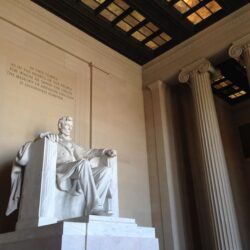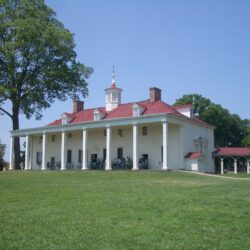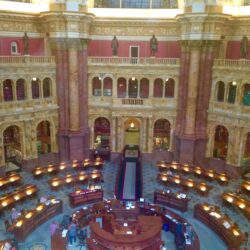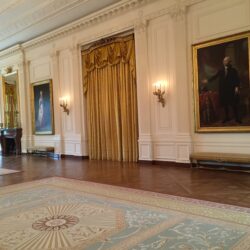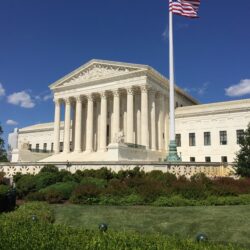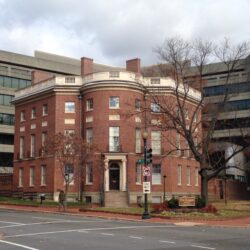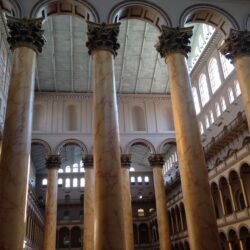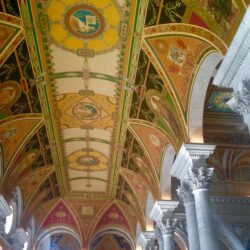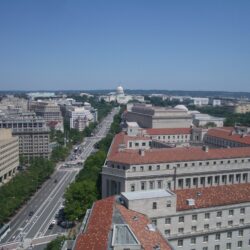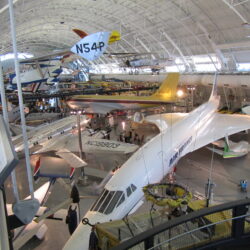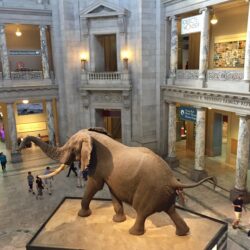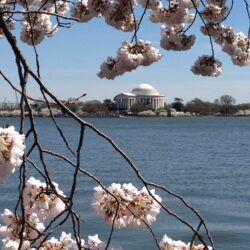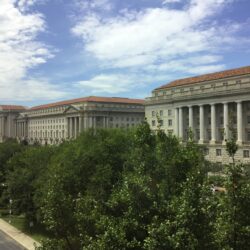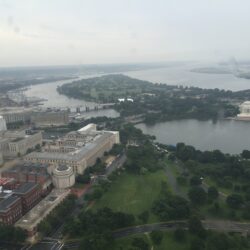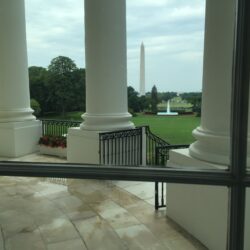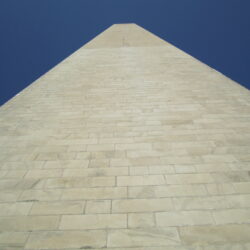A screenwriting class that gives Washington, DC sightseeing advice too? Yes!
.
Some Selected Washington, DC Tourism Suggestions and Tips
The White House – A tour of the White House, sometimes considered the crown jewel of a Washington trip, can only be accomplished through tickets secured by your Congressman or Congresswoman or one of your two U.S. Senators. Any of those three offices can do it for you, but there is only one White House, the U.S. and world population (and, thus, the total number of tourists) keeps growing, and the White House tour slots are limited, so getting into the White House is not a simple matter. There are no White House-issued or public, walk-up tours of the White House. The Washington offices of House and Senate members usually have a “White House Tours Coordinator,” and you can look up the number for these Capitol Hill offices, call them, and ask for this staffer. Tours requests from these offices may be submitted up to three months in advance, but no earlier than that. On the lower end, they generally must be submitted at least a few weeks in advance for security check reasons. Applicants for tickets will be required to provide Social Security number, citizenship, and/or other security information, and a background check will be run. Spring is the toughest season to get into the White House, with March and April being the toughest months, due to surges in tourism during school spring breaks and cherry blossom blooming weeks. One to two months out from these peak months, all White House tour slots may be booked. Fall, especially late fall, and winter, especially early winter, are much better for scoring White House tickets. Summer might be thought of as “medium” in terms of the degree of difficulty. While asking a congressional office for White House tickets more than three months may or may not even be allowed by the congressional office, asking less than three months out lowers your chances with every less week you ask. And, again, at some point a few weeks from your visit to Washington, you pass a point of no-can-do in terms of there being enough turnaround time for the security check required for all White House visitors.
U.S. Capitol – There is a U.S. Capitol Visitor Center that was built under the east front lawn and plaza of the Capitol. The Visitor Center has a website that offers tour tickets of the Capitol. The Visitor Center comes complete with an orientation film, small museum, gift shop, and a cafeteria. Some congressional/Senate offices also may offer staff-led tours of the Capitol, but, if so, it is the same tour as offered by the professional Visitor Center tour guides. You can also walk around the Fredrick Law Olmsted-designed grounds of the Capitol yourself, seeing the Ulysses S. Grant Memorial, the summerhouse, and, if you’re lucky (or unlucky?), a press conference at the House triangle or Senate “swamp” on the east side of the building.
Washington Monument – Timed tickets are required to go to the top of the Washington Monument, and those tickets tend to sell out, so getting them several months in advance is recommended. On the way up and down, you get some interesting background on the history, including the ceremonial history, of the great obelisk’s construction. As the world’s tallest stone structure, it offers great views of D.C. (although the top of Washington National Cathedral is actually at a higher elevation). If you miss the opportunity to get tickets in advance, the Monument may offer some same-day tickets distributed first-thing in the morning, but the line to get these, especially during decent weather, can begin to form a couple of hours in advance.
Smithsonian Institution museums – The world’s largest museum complex and research organization offers free admission. Staples on the National Mall are the:
- National Museum of the American Indian (the building itself is a work of art)
- National Air and Space Museum
- Hirshhorn (modern art) Museum and Sculpture Garden (also check out and snap a picture of Juan Munoz’s otherworldly Last Conversation Piece on southwest corner of the close Hirshhorn grounds, near Independence Avenue)
- National Museum of African Art
- Sackler and Freer Galleries of Asian Art (don’t miss the somewhat out-of-place Peacock Room at the Freer)
- Smithsonian Castle building and Enid A. Haupt (south grounds) garden
- National Museum of African American History and Culture
- National Museum of American History (see George Washington’s dress military uniform, the Fort McHenry flag that inspired Francis Scott Key to write the Star Spangled Banner, Edison’s first publicly demonstrated light bulb, Dorothy’s ruby slippers from the Wizard of Oz movie, and the Greensboro lunch counter)
- National Museum of Natural History (includes the Hope diamond, the eye-popping Hall of Mammals, an impressive exhibit on the origin of humans, and great IMAX movies)
Other Smithsonians NOT on the Mall include the:
- National Portrait Gallery and American Art Museum (at Gallery Place)
- National Postal Museum (next to Union Station)
- National Air and Space Museum – Udvar-Hazy Center (this is the second Smithsonian Air & Space museum that’s situated essentially on the extended grounds of Washington Dulles International Airport and the location of many big aircraft, including the Enola Gay [dropped the atomic bomb on Hiroshima], a Lockheed SR-71 Blackbird, an Air France Concorde supersonic airliner, the Space Shuttle Discovery, and many other historic military planes)
National Gallery of Art – This museum is also on the National Mall, and, even though identifying highlights of any major national gallery of art is perhaps a questionable endeavor, Leonardo da Vinci’s Ginevra de’ Benci is not to be missed. Nor should one miss the Gilbert Stuart first several presidents’ portraits, Thomas Cole’s Voyages of Life (4) paintings, Jacques-Louis David’s Emperor Napoleon in His Study, Renoir’s A Girl with a Watering Can, or Monet’s Japanese Footbridge; The Houses of Parliament, Sunset; Woman with a Parasol – Madame Monet and Her Son; and Jerusalem Artichoke Flowers. The Gallery’s East Building, built to house the Museum’s collection of modern art, received a national design award from the American Institute of Architects and served as the inspiration for the exterior of the Washington National’s baseball stadium in southeast D.C.
National Archives – This building is almost situated on the same edge of the National Mall as its neighboring museums (from the south side of the Mall it appears to sit on the north side of the Mall), but it is actually one block north of the other museums, (sort of) in between the Museum of Natural History and the National Gallery of Art West Building. This where you can view the Declaration of Independence, the Constitution, and the Bill of Rights. If you argued before the U.S. Supreme Court in a constitutional case that some parts of the Constitution no longer apply because they are quite faded (physically), you would be half right, albeit on track for a legal defeat. An original version of the 1297 Magna Carta is also housed in the building’s main chamber, the Rotunda for the Charters of Freedom. There are also other exhibit galleries where you can see, on a rotating basis, additional fundamental American documents, like the Emancipation Proclamation and the Louisiana Purchase Treaty, and other items of interest from American history.
West Mall and Tidal Basin memorials – West of the Washington Monument, around the Lincoln Memorial reflecting pool, you’ll find the World War II Memorial, the Vietnam Veterans Memorial (The Wall), the Lincoln Memorial, and Korean War Veterans Memorial. Around the Tidal Basin are the Martin Luther King, Jr. Memorial, the FDR Memorial, and the Jefferson Memorial. The two circuits somewhat “connect” at the WWII and MLK, Jr. Memorials, as those two are fairly close to each other. One tip on visiting these seven Washington highlights is to consider doing so at night. They are all open at night, so one can do other things during the day and hit the Memorials after dinner. Parking is also easier (and closer) at night.
U.S. Supreme Court – During the business week (only), you can visit the Court and, when the Court is hearing an appeal, on a first-come, first-served basis, observe oral arguments. See the Court’s website for its schedule and more information on visiting.
Ford’s Theatre – Even though all that’s left of the former building, which was once a meeting house for a Baptist church, where President Lincoln was shot is part of its façade, the reconstructed theater, which is still used as a theater, is an engaging and imagination-provoking re-creation of the space where John Wilkes Booth committed one of the most infamous acts in American history. In the basement is a museum about the assassination, complete with artifacts from the fateful event, and, across the street from the Theatre, is the Peterson House, where the wounded president was taken and where he died. The middle part of the 500 block of 10th Street NW is historical downtown Washington at its best.
Arlington National Cemetery – Highlights include the Tomb of the Unknown Soldier(s), which features a precision-laden changing of the guard every hour or half hour (depending on the season), the gravesite of President John F. Kennedy and its eternal flame (which is right next to the gravesite of Robert F. Kennedy, which is right next to the gravesite of Edward M. Kennedy), and the Custis-Lee mansion, a pre-Civil War home of Robert E. Lee and his wife and the reason for the selection of that particular estate for a U.S. military burial ground, which commenced with Civil War federal casualties. Trams take visitors around to these main sites. The cemetery also has its own Metro rail stop, from which one can also walk to the Marine Corps (Iwo Jima) Memorial.
Bureau of Engraving and Printing – Congressional-office obtained tickets AND public, early morning-issued tickets are available. See paper money-making.
Washington National Cathedral – This Episcopal cathedral, officially the Cathedral Church of Saint Peter and Saint Paul, is the sixth largest cathedral in the world. It’s also the burial place of Woodrow Wilson, the only president buried in D.C., and the ashes of Helen Keller. Cathedral-atypical architectural features include an outer space-themed stained-glass window with an Apollo 11 moon rock in its center, a stained glass window of Robert E. Lee and Stonewall Jackson, a choir pew carving of a (British) lion eating a snake bearing the (difficult-to-recognize) face of Adolf Hitler, and an outside, upper-reaches gargoyle in the shape of the helmet-head of Darth Vader. The front towers observation deck gives great views of the city. Official tours are given by guides. The Cathedral is not near a Metro rail stop, so you have to take a cab or other transportation there.
Newseum – This is a private museum about news coverage of historically significant events. Because it’s private, comparatively pricey tickets are required, but it’s a tourist crowd favorite, and for good reason. It’s also in a great/convenient location on Pennsylvania Avenue steps away from the back of the West Building of the National Gallery of Art.
Old Post Office Pavilion – If you can’t get tickets to the top of the Washington Monument, the top of the Tower tour at the OPOP offers the best views of Washington – and the observation area is open air! Pretty great/convenient location = On Pennsylvania Avenue steps away from the Federal Triangle Metro stop.
National Zoo – Lots of walking required, but a great zoo for the space it takes up in Rock Creek Park, a gem for Washington’s residents. The zoo has an extensive Panda history, and the zoo’s layout is unique for the stark difference between its front and back entrances. One is squeezed beside an urban sidewalk, while the other opens up into one of the largest, big-city urban parks in the country. The zoo is run by the Smithsonian Institution, so it’s free. The Connecticut Avenue entrance is a good place to catch a cab to the National Cathedral, which is not that far away.
Mount Vernon – This tourist attraction is not run by the federal government or Smithsonian and is ten miles south of Old Town Alexandria, which pre-dates Washington, D.C., down the George Washington Parkway. On a temperate, sunny day, the ride from Old Town to Mount Vernon makes a great bike ride. Lines for the house tour can be long, but pictures on the front lawn after you’re done are very nice. And the museum about Washington’s life on the grounds in very good.
United States Holocaust Memorial Museum – This museum is really an experience, and a very emotional/moving one at that. The museum is a study of the historical events of the Holocaust, a reverent remembrance of the millions of lives lost, and an inspiration to prevent hatred and promote tolerance and respect for all. Advance tickets are required. The museum is right next to the Bureau of Engraving and Printing, near both the Washington Monument and the Jefferson Memorial.
U.S. Botanic Garden – This is an oddball property of the Congress (so it’s free), situated at the base of Capitol Hill near the western end of the Rayburn House Office Building. Highlights are the glass-domed jungle room, which includes great views of the U.S. Capitol Dome from its mezzanine/upper level walkway, the orchids room, and the cactus room.
National Arboretum – Not to be confused with the Botanic Garden, this expansive natural area in northeast Washington features the majestic placement, in the middle of an expansive meadow, of 22 columns that at one time were part of the east portico of the U.S. Capitol. When the east front of the Capitol was expanded 32½ feet after the cast-iron dome was added, these columns were removed. A visit to the Arboretum requires a car or bus ride.
Phillips Collection – Near DuPont Circle, this private museum houses Renoir’s large and exhilarating Luncheon of the Boating Party, which, for understandable reasons, is some people’s favorite painting in Washington.
Octagon House – Not too far from the White House and the Ellipse, this eight-sided house was used as a temporary White House by James Madison after the British burned the White House in the War of 1812. The treaty of Ghent was signed by President Madison there, and you can tour the house.
Great Falls Park (VA) and the C&O Canal at Great Falls Tavern (MD) – Not many non-Greater Washingtonians know that there is a cascading set of waterfalls and cliff-lined gorge just outside the Capital Beltway, but there is. It takes a car to get there, but, on the Virginia side of the Potomac River, there is Great Falls Park, which has the best view of the highest waterfall. A trail just west of the visitors center at the falls eventually forks left onto a partially marked and partially makeshift trail along the eye-opening rim of Mather Gorge, the cliffs of which are a little higher on the Virginia side of the river and thus host rock climbers in warm months. On the Maryland side of river, which by car is a completely different trip (there’s no bridge near the two sides at that point in the river), is a unique part of the 184-mile long Chesapeake & Ohio Canal park (the designation there is the Great Falls Tavern Visitor Center). It features a gentle walkway to a falls-viewing point on Olmsted Island, which is a somewhat different view compared to Virginia park, and the popular Billy Goat trail, a strenuous (and slightly dangerous) rock-scramble route along the Maryland rim of Mather Gorge. A trip down the first two loops on the Billy Goat trail really reminds one of Colorado or West Virginia. The C&O canal is still flooded and tourism-functional on the Maryland side, whereas an older canal spearheaded by George Washington on the Virginia side, the Patowmack Canal, is now in dry ruins. Both sides are quite unique for a Washington, D.C. tourist experience.
Civil War Battlefields – If you are in Washington for several days, or have already visited the National Mall attractions and museums enough, consider heading out of town to one of the major Civil War battlefield sites that are not that far away, like Chancellorsville/Wilderness/Fredericksburg (VA), Manassas (VA), Antietam (MD), or Gettysburg (PA). Burnside’s bridge at Antietam has a great historical feel to it, and the impressive Visitor Center and Cyclorama, High Water Mark, Devil’s Den, and Warfield Ridge Observation Tower at Gettysburg are definitely worth seeing. If you take a trip to Gettysburg, watch the 1993 four-hour movie GETTYSBURG – or read The Killer Angels – first, just to understand the complicated layout and three-day evolution of the battle. Other potential day trips outside of Washington include visiting historic Annapolis, Maryland and the U.S. Naval Academy and visiting historic Harper’s Ferry, West Virginia.
Site of the Beatles’ first North American concert (not counting the Ed Sullivan studio appearance in New York as a “concert”) – This site is the former Washington Coliseum, before that called Uline Arena, at 1132, 1140, and 1146 3rd Street NE in the old Swampoodle/new NoMA neighborhood. The site is currently an REI flagship store.
Other notable Washington attractions include the:
- Kennedy Center for the Performing Arts
- Library of Congress
- National Building Museum (the building itself is wow-ing, especially the interior)
- National Museum of Women in the Arts
- Pentagon
- National Shrine of the Immaculate Conception (the Catholic national cathedral)
- Franciscan Monastery of the Holy Land in America (see it too, if you visit the National Shrine – they are not far apart)
- Folger Shakespeare library and theater (it’s next to the Adams Library of Congress building)
- International Spy Museum, a private museum with an interesting gift shop
- Daughters of the American Revolution Museum
- Marine Corps evening parade at the Barracks Row Marine Corps Barracks in SE Washington (near Eastern Market, another worthy stop), which happens on Friday evenings in the summer months
- National Museum of the U.S. Navy
- Air Force Memorial on the hill above the Pentagon in Arlington
- Museum of Crime and Punishment
- Historic Georgetown and Old Town Alexandria
- President Lincoln’s Cottage (“summer White House”) at the Soldier’s Home
…And the above list doesn’t even include seeing a musical or play in downtown Washington at the National Theatre, Warner Theatre, Arena Stage, Studio Theatre, Landsburgh Theatre, Wooley Mammoth Theatre, or Harman Center for the Arts, which (sort of) rival Broadway.

